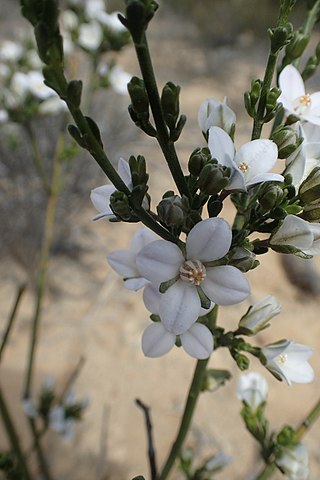
Banksia purdieana is a species of bushy shrub that is endemic to Western Australia. It has broadly linear, pinnatipartite leaves with sharply-pointed lobes on the sides, yellow flowers in heads of about eighty and egg-shaped follicles.
Ludwig Eduard Theodor Lösener was a German botanist who collected widely in the field in Germany: Amrum island (1912), the Alps, the Black Forest, Bavaria, Rügen island and Tyrol in modern Austria. His speciality was the Aquifoliaceae of the world. He also studied cultivars of Ilex species. His name is often spelled as 'Loesener' in English sources.
Ernst Georg Pritzel was a German botanist.

Acacia aestivalis is a shrub belonging to the genus Acacia and the subgenus Phyllodineae that is native to Western Australia.
Grevillea eremophila is a species of flowering plant in the family Proteaceae and is endemic to the south-west of Western Australia. It is an erect shrub with leathery, linear to narrowly egg-shaped leaves with the narrower end towards the base, and creamy-white flowers.

Grevillea incrassata is a species of flowering plant in the family Proteaceae and is endemic to inland south-western Western Australia. It is an erect shrub with crowded cylindrical or narrowly linear leaves and clusters of bright yellow flowers.

Grevillea uncinulata, also known as hook-leaf grevillea, is a shrub of the genus Grevillea native to an area in the Wheatbelt, southern Mid West, northern Great Southern and western Goldfields-Esperance regions of Western Australia.
Baeckea elderiana is a species of flowering plant in the family Myrtaceae and is endemic to central Western Australia.
Baeckea grandibracteata is a species of flowering plant in the family Myrtaceae and is endemic to central Western Australia. It is an erect to spreading shrub that typically grows to a height of 0.15 to 0.9 metres and blooms between September and December producing pink and white flowers. Found on undulating sand-plains in the eastern Wheatbelt region of Western Australia in the area around Yilgarn, it grows in sandy and sandy loam soils.
Baeckea grandis is a species of flowering plant in the family Myrtaceae and is endemic to the south-west of Western Australia. It is an ascending to low-lying shrub that typically grows to a height of 0.1 to 0.5 metres and blooms between September and December producing pink and white flowers. Found on sand-plains and hills in the Mid West and northern Wheatbelt regions of Western Australia, it grows in sandy and lateritic soils.
Gunniopsis zygophylloides, commonly known as the twin-leaf pigface, is a succulent plant in the iceplant family, Aizoaceae. It is endemic to Australia.
Hibbertia andrewsiana is a species of flowering plant in the family Dilleniaceae and is endemic to the south-west of Western Australia. It is a shrub with an erect or spreading habit and typically grows to a height of 15–60 cm (5.9–23.6 in). It blooms between September and January and produces yellow flowers.

Cyanothamnus fabianoides is a plant in the citrus family, Rutaceae and is endemic to the south-west of Western Australia. It is a compact shrub with many branches, simple, more or less cylindrical leaves and single white, pink or pale blue four-petalled flowers in the leaf axils.

Leucopogon oliganthus is a species of flowering plant in the heath family Ericaceae and is endemic to the south-west of Western Australia. It is an erect, open shrub with white, tube-shaped flowers from August to November.

Philotheca tomentella is a species of flowering plant in the family Rutaceae and is endemic to the south-west of Western Australia. It is an undershrub with small club-shaped to cylindrical leaves and white flowers with a pale red central stripe, arranged singly or in groups of up to four on the ends of branchlets.

Blennospora phlegmatocarpa is a herb species in the family Asteraceae. It is found in Western Australia.

Psammomoya choretroides is a small shrub in the Celastraceae family, endemic to the south west of Western Australia. It was first described by Ferdinand von Mueller in 1889 as Logania choretroides, but was transferred to the genus, Psammomoya, in 1904 by Ludwig Diels and Ludwig Eduard Theodor Loesener.

Chenopodium preissii is a plant in the Amaranthaceae family, native to Western Australia and South Australia.

Leucopogon dielsianus is a species of flowering plant in the heath family Ericaceae and is endemic to the south-west of Western Australia. It was first formally described in 1904 by Ernst Georg Pritzel in Botanische Jahrbücher für Systematik, Pflanzengeschichte und Pflanzengeographie from specimens collected near Tammin. The specific epithet (dielsianus) honours Ludwig Diels.

Sclerolaena hostilis is a species of flowering plant in the family Amaranthaceae, native to Western Australia. It was first described in 1904 by Ludwig Diels as Bassia hostilis, but was transferred to the genus, Sclerolaena in 1921 by Karel Domin.












